We just arrived at the airport in Amsterdam. Layover is 4 hours.
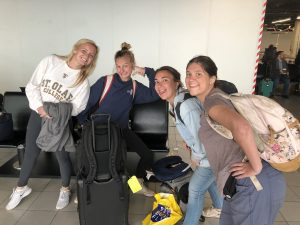

Just another web site
We just arrived at the airport in Amsterdam. Layover is 4 hours.

Departure from Accra.
We depart today from the Kotoka International airport in Accra for Minneapolis through Amsterdam.
We started out with usual breakfast at Pink Hostel and checked out by 10:00 am.
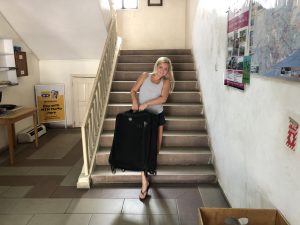
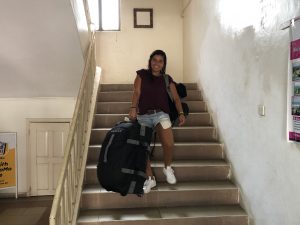
Our last breakfast at Pink Hostel.
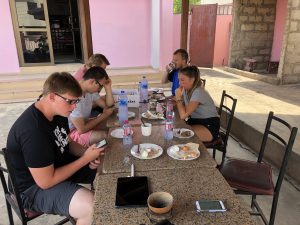
Our flight was at 10:10 pm but traffic in Accra foreced us to move towards the airport to camp at the Accra Mall, which is a few minutes drive from the airport. We had lunch at the Mall, did our last minute shopping, and just waited.
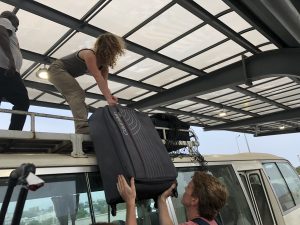
At the airport, we gave Prof. Iddrisu, Jazee, and Kwabena signed cards, and expressed our appreciation for their countless support during our stay in Ghana, and for making the program such an awesome one

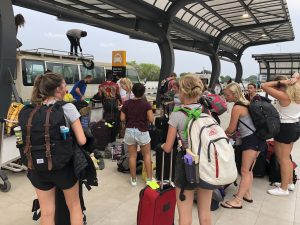
Above , picking our luggages for check in at the airport in Accra. Our flight left at 10:10 pm and due to arrive in Amsterdam by 5:00 am.
Blogpost for Jan 30, 2019
This morning we woke up at the usual time for breakfast, but it stated drizzling shortly afterwards. After waiting for the rain to clear up, one group of us headed to the beach, and another group left to check out some nearby museums. The museums, were unfortunately, underwhelming. The National Museum of Ghana was mostly closed for renovations, but did have a small exhibit dedicated to historic Ghanaian architecture. The Science and Technology Museum was also pretty barren, save for the remnants of a recently-closed exhibit focused on light. The most important thing we learned from there was that the Ghanaian musical style called “Highlife” was the soundtrack to the Ghanaian independence movement, and continues to be performed today. The National Theatre was also closed, so all we got were a couple of close-up photos of the unique architecture. To cap off our walking tour, we entered the Movenpick Ambassador Hotel to view the contemporary Ghanaian art that they had on display. The luxurious hotel had a number of works recovered from an ambassador hotel that stood in the same place as the Movenpick almost 2 decades ago. A number of small statues, traditional kente, and two-story tall paintings also adorned the walls of the hotel. A hotel employee walked us around the hotel to explain the context of the art and even allowed us into the hotel ballroom to look at several immense paintings there.
The group that headed toward the beach went to the Labadi Hotel and enjoyed a wonderful afternoon relaxing and swimming. There was a lot of trash in the water, which was strange to us because it is a massive tourist area and it was not well maintained. There was also a lot of haggling and pictures being taken of us, which made some of us uncomfortable, but we ignored them and went on with our normal business.
We enjoyed a delicious lunch, however, we were unfortunately overcharged for our food. A few of us tried to get some of our money back but due to the language barrier and the stubbornness of both sides, we ended up giving in and leaving after 20 minutes of arguing.
We came back to the hotel to rest and shower before dinner. After dinner, many of us sat around sharing stories and laughter.
It is Erin’s birthday today and Prof. Abdulai surprised her with a birthday cake!
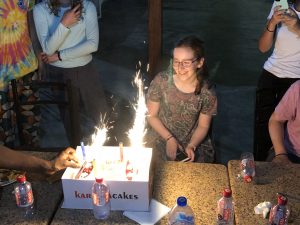
What a great way to end our last night in Ghana 🇬🇭!
Blogpost for January 29th 2019
Today we started off the day by heading to a local light house in Accra. When we arrived we found out that the James town light house was under renovation so we couldn’t see it so we quickly had to improvise. The nearby James Fort, now used for prison but still accessible to the public, was also locked, and the staff with the keys was very absent. Luckily there was a local man, Daniel Addo, was willing to show us some significant landmarks in the area that were related to the Atlantic slave trade.
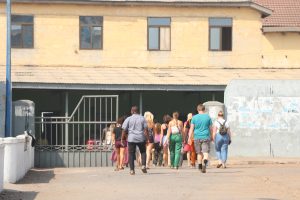
We then moved to and adjacent building to the James Fort, where the colonial masters lived and sold slaves.

It’s now used as a gym where a lot of famous boxers such a Azumah Nelson have trained. The gym was very interesting because under the gym there was the entrance to the slave dungeons that were connected to Fort James.
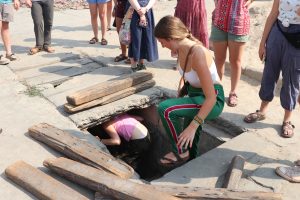
The dungeon, now blocked, has only the opening and part of the dungeon still accessible. Used to lead to the James Fort through which slaves were shipped abroad.
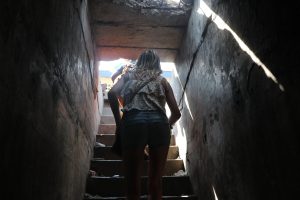
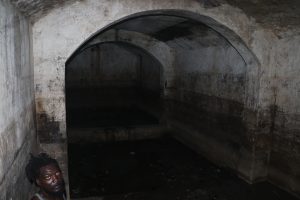
A very interesting juxtaposition of young people playing basketball over a very historic site right under them.
Afterwards we went to lunch at a restaurant owned by a family of David, and Ole.
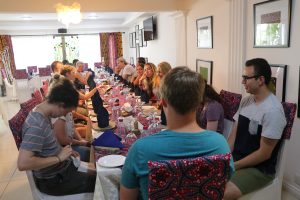
The family had hosted last year interim Ghana at the same place. It was buffet style and it featured all the traditional Ghanaian dishes.
We also got to meet up with the other Olaf group in Ghana. This group was made up of 5 computer science majors that were collaborating with students from a liberal arts college, Asheshi, to make a math app to help students in Ghana learn how to do addition in a more effective way. It was fun to share stores and catch up with campus friends.
After lunch we went back to the Pink hostel with the other group so they could quickly use the WiFi, the bathroom and grab some water before they headed on their way. Sadly the other group is leavening tonight so we will not be able to meet up with them again.
The rest of the day was spent taking naps and relaxing until dinner. Dinner was very good and all of us went to sleep happy
Blogpost for Jan 28
Today we woke up to a delicious breakfast at the Pink Hostel with yummy avocados and tomatoes. We had a big day ahead of us, so we ate early in the morning compared to usual. We left Accra for Cape Coast, a city a few hours away from us, where we visited the University of Cape Coast. While there, we listened to a lecture from Prof. Osei Kwarteng. Prof. Kwarteng is a former classmate of Abdulai, at the same university and now serves as the head of the university history department. Furthermore, he was selected by the government to lead the national curriculum development committee where he’s advocated for an initiative to increase history requirements in Ghana’s core curriculum. He informed us that by September, History would be made compulsory from the basic level upwards.
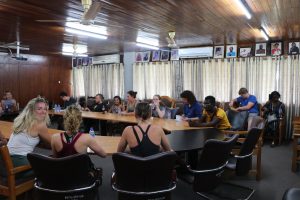
In the lecture we discussed many topics, beginning with the differences between the Atlantic, Saharan, and Arab slave trades. We learned that the slaves traded in the Trans-Saharan slave trade were primarily victims of the political model of slavery, as many were either prisoners of war, victims of pawnage, or criminals. We also learned that in the Arab trade slave traders went into the interior to capture people for slavery. These slaves were often castrated or made concubines. The slave trade led to significant depletion of the African population and also led to a 300-year developmental gap. The bulk of the information pertaining to the Trans-Atlantic trade was similar to what we had already covered throughout the course. But then, there was also domestic slavery and slave trade going on even after abolition.
Following the discussion of the three slave trades the Professor discussed the rationale behind studying history pertaining to the slave trade, as well as the dynamic that is made present between different groups of society when the slave trade is studied in depth. With regard to history, the professor spoke about the value he sees in understanding the past in order to ensure that the evils of the past are never repeated. Furthermore, while he identifies that there are evil people in the world, he firmly believes that understanding history makes us more well equipped to prevent evil behavior.
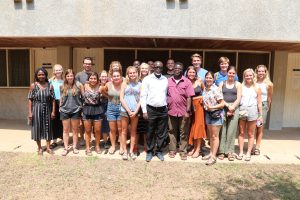
After our lecture we ate lunch at the cafeteria on campus, at the Sasakawa Global 2000 initiative launched by US president Jimmy Carter.
Elmina Castle
We all filled ourselves up and then left for Elmina Castle. Upon arrival we met with our tour guide, Alex, in the Portuguese Church in the center of the castle. Alex provided us with incredible insight into the history of Elmina Castle and the slave trading activity that took place on the coast. Alex explained that there are very few remaining castles along the coast, as the final three large remaining castles are the Danish castle in Accra, the British Cape Coast Castle, and Elmina Castle which was built by the Portuguese. Elmina castle was originally built with the intent to be used for gold trading, hence the original Portugal title meaning “The Mine” however the locals couldn’t pronounce the word and it soon morphed into “Elmina.” Regardless of the original intent of Elmina, it soon became a focal point of the West African slave trade. We learned that initially the Portuguese would attempt to obtain slaves themselves, but soon began to collaborate with local communities in order to obtain more slaves. Different countries would work with different ethnic groups as they all vied for access to the profitable trade. The Portuguese were at Elmina for 140 years, 110 of which were years where Elmina was dominated by slave trading activity. The Dutch were also here for 235 years. Alex ended his introductory speech by explaining how the abolition of slavery did little to stop the slave trade, as it continued illegally for 5 decades. Our visit to the archives in Tamale, where we came across documents on slavery, dating to as late as 1930s is testament to its continued practice despite abolition.
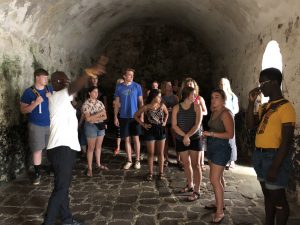
Our tour began with a visit to two different cells used to punish people at the castle. One cell was used for Europeans and the other cell was used for slaves. The cell used for Europeans had ample access to ventilation and light, while the slave cell was almost completely black and non-ventilated.
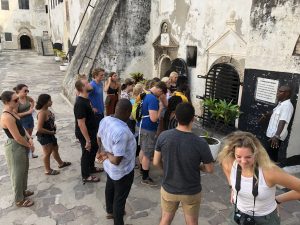
We learned that slaves would be left in their cell with no food or water until they either succumbed to starvation or various other causes of death. These cells immediately set the tone for the rest of the tour.
We then went to the female slave dungeons. We walked through a dark tunnel that eventually opened up into a courtyard surrounded by cells. These cells had a housing capacity of 400 female slaves who would be stored here for months at a time awaiting slave ships. In the center of the courtyard there were two key focal points. First, there was a water well.
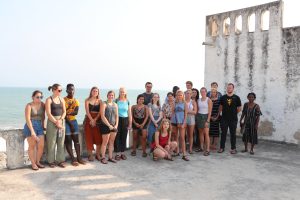
We learned that the officials of the castle would look down upon the women and select one of them to bathe in water from the well. They would then be brought up to the officers quarters were they would be sexually abused. If these women did not comply with these disgusting sexual demands they were at risk of significant punishment or even death. It was horrible and eye opening to see the juxtaposition of the luxurious officers quarters right above the slave dungeons, especially knowing about the horrible events that transpired there. Second, we saw a metal ball that female slaves would be chained to if they were not submissive to the officials.
They would be forced to stand in the hot sun while chained to this ball until their officials believed that they had been sufficiently punished.
We then went to the men’s slave cells. These cells were similar to the female cells, although they were smaller and much darker. There also would be many more slaves held in these confined spaces, as 600 male slaves would be held at a time. Alex told us that a few years ago they had 60 volunteers (much less than the amount of slaves that would be held in these cells) volunteer to be confined in these cells as an experiment. After only 12 hours the volunteers found the experience to be unbearable both physically and psychologically. Knowing that 60 people could not even handle 12 hours made for a much more powerful experience, as slaves would be held for many months at a time.
After seeing the men’s cells we then moved onward to the gate of no return.
On the bus ride to Elmina Castle, Prof. Abdulai told us that the phrase “gate of no return,” is a physical exit point from the castles onto the waiting boats, but also symbolizes the forced migration and the dispersal of the African people.
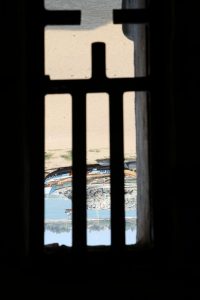
This is a small gate located in a confined part of the castle that is of incredible significance. This gate is the point at which slaves would be sent from the castle to the slave ships waiting at the beach. Once somebody had gone through this gate they were essentially considered to be a lost cause, as they were on their way towards a horrible life of slavery, never to return. Seeing this location was a powerful experience as it was the point at which hundreds of thousands of individuals were sent away never to be seen again. At one point an individual from our group asked Alex why the gate was so small, as it was notably narrow. Alex provided a morbid explanation, as he told us that by the time slaves were ready to be shipped off, their bodies would be so emaciated that there would never be any issue of them getting through the gate. This was intentional, as slave traders knew that if slaves were kept weak then there would be minimal chance of revolt. Furthermore, the death of slaves on their voyage was a point of minimal concern as a slave in the Americas could be sold for 20x more than in Africa.
Visiting the castles was an emotional part of the trip for the group. We started our journey in the Northern region of Ghana visiting slave camps and markets and then worked our way down to the castles on the coast, where the story comes to an end. As a group we have had many discussions regarding this journey the slaves endured, but seeing it made the texts become a sobering reality of the horrors that took place. After our tour, we had a brief moment of reflection, and then headed back on the bus to Accra. Back at the Pink Hostel, our dinner was delicious as always.
Mac, Maggie, Tina, and Clara
Blogpost for January 27, 2019
After waking up in Accra at the Pink Hostel, we had a lovely breakfast of bread, hard-boiled eggs, fresh pineapple and mango, and a phenomenal potato dish prepared by the hostel. Those staying at The Guest House had omelettes, fresh fruit, and toast for breakfast.
Following breakfast, the majority of us took advantage of the beautiful day and put on our swimsuits to head to the top-rated beach in Accra, the Bojo beach.

By midday, we arrived at the Bojo Beach Resort where we were taken by boat to a small island-beach where we were to spend the day.
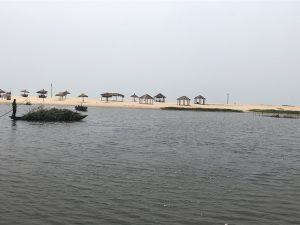
Immediately upon arrival, we rushed towards the ocean where we were met by the pleasant water and enjoyable waves to bodysurf and cool off from the beating Ghanaian sun.
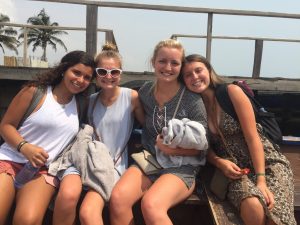
After our ocean needs were met, we ordered a lunch of beef, chicken, and lamb kebabs, French fries, and meat pies. Though the food took an ungodly amount of time to arrive to our thatched-roof escape from the sun, it gave us an opportunity to explore the beach, watch a dozen local fishermen haul a fish net from the waves, boost our melanin, enjoy hearty conversation, and read books.
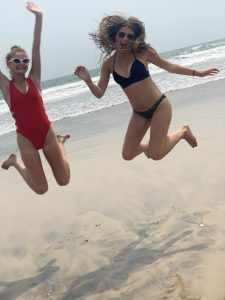
When our food finally arrived, we feasted quickly so that we could soon return to our beachly-activities. We then reclaimed our position among the waves and reveled in the luxury of the phenomenal scenery.
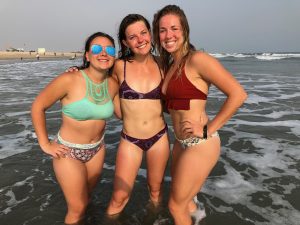

After a great deal of coercion, the group finally convinced Kwabena, our driver, to rise from his nap in the sand and take to the water where he ultimately frolicked and splashed for over an hour.
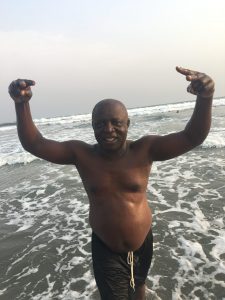
The time spent at the beach was an excellent way to spend our free day and we were incredibly grateful for the opportunity to sit back and relax for the afternoon.
For dinner, we returned to the Pink Hostel where we ate a beautiful meal of grilled chicken, rice with spicy green pepper sauce, and vegetable stew.
Our first day in Accra was incredible after spending two days traveling from the Northern Region of Ghana all the way to the southern coast. We are looking forward to the remainder of our time in Accra but the looming knowledge that our time here is growing smaller every minute weighs heavy on our hearts.
Ty, Zeeba, Ben, and Katie
Blogpost for January 26, 2019
After a long journey yesterday through the rolling hills, scattered with small villages and palm trees, we arrived in Kumasi. We were all exhausted and slept like new babies.
This morning, we woke up in the cozy Davellen Hotel and had a big breakfast of omelettes, oatmeal, bread, and fruits. We packed up the bus and were on the road again to the Manhyia Palace Museum. We went on an extensive tour of the Manhyia Palace, an.old palace of the Asantehene, built by the British I’m 1925, for king Prempeh I, who was returning from exile in Seychelles.
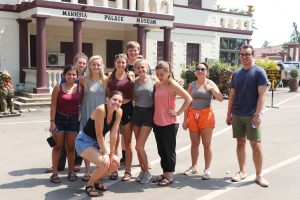
To summarize what we learned, here are a few key points:
– The Asante are a large kingdom of people in central Ghana that was founded in 1685 after the unification of many smaller states.
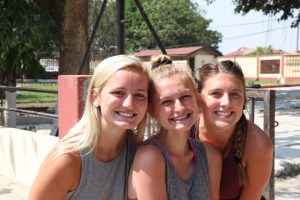
– The 13th King of the Asante people, Prempeh, became king at age 18. King Prempeh was given the Manhyia Palace by the British in 1925, after they had burnt down the first in the Segarante war of 1874, and upon his return from exile in the Seychelles, where he spent 28 years. Though the guide said, prempeh did not accept the palace until the Asante people paid for it, but he did not also provide information on where he lived upon his return.
– The most important item to the Asante people is the golden stool. It is believed to have arrived to the first King from God.
– Sir Fredrick Hodgson demanded that the golden stool be handed over to the British during the colonial era. Queen Yaa Asantewa quickly had a replica made of the gold stool and handed it over to the British. Once the British had discovered her deception, she was exiled to Seychelles, where she later died.
– The 14th King named Otumfuo Opuko Ware II lived in the Manhyia Palace from 1931 until 1970 and in 1995 he converted the old palace into a museum.
We questioned why the tour guide did not discuss slavery as a part of Asante history. The guide tried to distance Asante from the slave trade, stating that it was the British who captured slave but the Asante only went to war for territorial expansion. Of course, through these wars slaves were gotten, and sold old. Asante was one of the mighty slave kingdoms of West Africa. We noticed that there was a silencing of slavery and repositioning of the Asante role within the history of the slave trade.
Is it guilt or shame? These are some of the questions the class will grapple with. Meanwhile, as a class, and on the bus, we came up with various answers to why the Asante have chosen to disregard their past. We thought that because the Asante kingdom is so powerful, speaking about slavery brings shame. It also indicates the desire to maintain a position of ‘rightness’ and morality in the history of the Asante region, and attempts to diminish resentment from those who suffered from their slaving activities, and for their role in the slave trade.
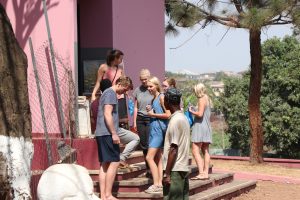
Other issues that came out had to do with Asante relations with people to the north and how much borrowing has taken place. A question on the taking drums led to the claim by the guide that it was introduced by an Asanteman, to which Prof. Iddrisu questioned the Asante name of “Atimpane”, and said it was a corruption from the Dagomba “timpana.” The talking drum is essentially a Dagomba thing. Other drums found at the palace and in Asante are Dagomba.
The second issue related to ancestry. The guide told us Asantes had intermarried with the MogoNabe’s people of the Moshi and a reason they are tall, pointing to gift from the MogoNaba. A flimsy evidence. But then the Asantehene in national TV and in audiencee with the president of Ghana, mentioned their relations with the Dagomba people. Yes, the king is descendant from Naa Garba, a seventeenth century king of Dagbon, who gave his sister to the Asantehene. The current Yaa Naa has taken that name and was outsourced a few days ago as Naa Garba II. It’s an issue of retelling and a desire by people to change the history. But even then, the guide can not be blamed, for he lacked the knowledge of a guide of such a place as crucial as this museum.
After our tour we hopped on the bus for another delish meal at Ike’s.
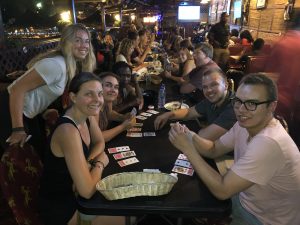
We made a quick stop at the Kumasi cultural center to pick up a few more souvenirs and artwork before we were finally on our way to Accra. The trip was long, but luckily the scenery was beautiful. The landscape consisted of lush green covered mountains and the roads were lined with people selling fresh fruits and vegetables.
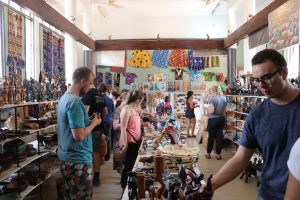
We arrived in Accra a little after 8:00pm and were greeted by the friendly workers at the Pink Hostel and the Guest House. Some students helped themselves to a little dinner at the Pink Hostel, but most of us took a warm shower and went right to bed.
Love,
Ella, Kristina, Morgan, and Vanessa
Blogpost for Jan 25/01/19
En route to kumasi
To start the day, we woke up early for our last breakfast in Tamale. After loading up the bus, we departed for Kumasi.
After a long drive with a few short stops, we were greeted in Kumasi by a great deal of traffic. This made our trip across town longer than we had anticipated. To help keep our minds busy during this long drive, we listened to music on a speaker and then started singing pop tunes from our childhood.
Finally, we arrived at our accommodations for the night, the Davellen Hotel. After dropping off our luggage, we made another trip across town to Ike’s Restaurant, where we had our supper while we listened to some live music.
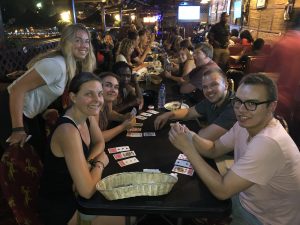
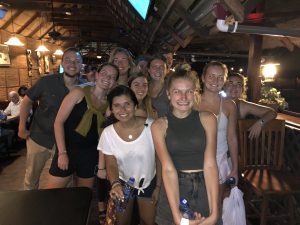
Finally, we returned to our hotel and retired for the night. News in Brief: the newly appointed Yaa-Naa, Chief of Dagbon, is prepared for his investiture. Preparations for the event have been ongoing throughout the day. The Ghanaian Roads Minister laments that only 23% of Ghana’s road system is unpaved. Government officials cite economic issues and a large inherited debt as the main sources of consternation in making progress on road development.
Blogpost January 24, 2019
Mannie is a Ghanaian-Italian first year from Chicago that came to Ghana for the first time in order to learn about slavery and also meet his family for the first time. Prof. Iddrisu secured a ticket previously for Mannie to go to Kumasi to meet the uncles and grandma. And with the agreement of Mannie’s uncle, who agreed to stay in contact with Mannie’s until he gets to kumasi, Abdulai got Mannie into the Government Transport at the Tamale Transport Yard, at 4:30 am. This will be Mannie’s first time meeting with his grandmother. He met the uncle when we passed through Kumasi last three weeks. This was a 7 hour bus ride and Mannie made it safely to Kumasi.
“ It was really nerve racking going all the way to Kumasi by myself but it was also very exciting meeting my Ghanaian family for the first time. It has been such an experience finally getting to be home and live within my own culture.” said Mannie
Mannie’s uncle picked him up from the bus stop at exactly 2:47.
Mannie met his grandma for the first time in his life.
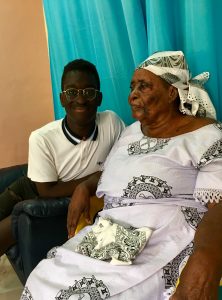
The rest of the group got to sleep in until 9 and after breakfast at our usual joint, we had multiple groups do different things on our free day/last full day in Tamale. We had a picture with Fussey, owner of MilikiKuul, where we had the sumptuous meals.
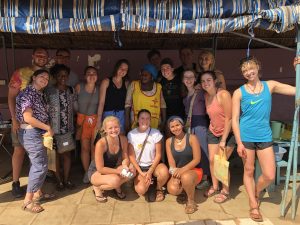
One group went back to the Tamale Central market where we shopped at a couple days ago and at the Center for National Culture that had lots of touristy souvenirs and cool artwork painted by some of the locals.
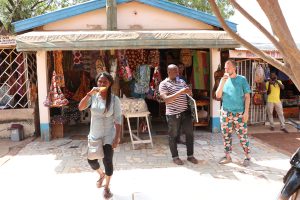
We went back through all shops to make our last minute purchases for family and friends before leaving Tamale.
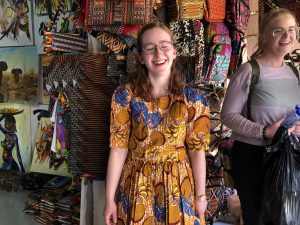
Prof. Abdulai took a different group of us to the market. We managed to squeeze 7 people into his Suzuki Grand Vitra, and it was quite the Ghanaian driving experience. He helped us look for African fabrics and black soap. However, a trip to the market with Abdulai involves him making a series of stops to say hi to people because he knows everyone. We spent time at the fabric store picking out fabrics for Morgan and Matt to take back to the States. After the market we squeezed back into Abdulai’s Four Wheel car and drove to the cultural center to meet the rest of our group.
After that was lunch at the usual spot and then afterwards a small group went to a local bakery to get bread for our long trip to Kumasi the following day.
Later that evening, most of us went to the youth and cultural center to play some basketball, volleyball, and soccer with some of the people there.
It was a very fun way to end our final day in Tamale!
Blogpost for Jan 23:
After our usual breakfast our day began with a lecture/discussion led by Prof. Abdulai that focused on a paper titled “The Impact of the Atlantic Slave Trade and Western Sudan” by Martin Klein. It sought to reinterpret Philips Curtin’s analysis of the demographics of Slavery in Africa, which evoked several responses from African scholars such as Baboucar. Philips Curtin ignored the emotions any discussion of Slavery evokes in people particularly impacted by it. But Martin Klein, who comes to his support, argues in this paper that Curtin be forgiven, for he only pointed to where the data led him.
The paper discusses the differences between the economic model and the political model of slavery. In the political model, slavery is considered to be an outcome of territorial expansion, and any prisons of war or slaves acquired are only a byproduct of expansion. In the economic model, slavery is viewed as a profit-driven business model above all else. One of the key components of the paper/lecture/discussion was the price fluctuations that can be observed in the literature pertaining to slave markets. These fluctuations are indicative of non-economic events such as famine, drought, or some form of political instability (ex. war). When one views slavery in the context of such events the political model becomes more relevant. In many ways these models overlap as political issues are often inherently economic, and vice versa.
We also engaged with the topic of societies’ level of dependence on slavery before, during, and after the trans-atlantic slave trade. The pervasive nature of the slave trade led to the deterioration and reshaping of the economic and political structures that acted as foundational elements of many societies. During the slave trade one can observe that the modes of production and levels of exploitation in these societies were completely transformed, leaving societies exposed to increased levels of economic and political instability.
We also noted that as time progressed, slave traders began to assign increased value to male slaves. Traditionally, female slaves had been viewed as preferable as they maintained adequate work capacity in addition to a capacity to complete domestic tasks not done by male slaves. This changed as the trans-atlantic trade progressed for a few reasons. First and foremost, strong men were better suited for surviving the harsh conditions slaves had to endure while moving from inland areas towards the coast. Second, the purchasing parties (ex. the Americas) placed increased emphasis on sheer labor force and productive capacity, thus negating any value assigned to domestic tasks. At the peak of the trans-atlantic trade 60-70% of the slaves exported were male.
Evening Entertainment
After we had wrapped up our lecture and discussion we ended the day with another visit from the youth center dancers. The first dance that they performed was called the Paki.
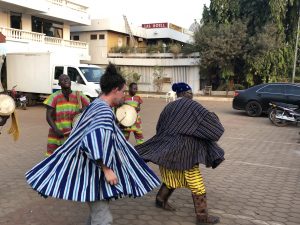
This dance was about a young man who was eager to prove his own self worth. In order to do so he had to obtain certain attire (ex. a smock), as this would signal to his community that he had become an independent man. This dance would traditionally be performed at a market after a long day of work. This dance acted as a venue for socializing and created an avenue for potential relationships to develop. The performers mentioned that some young men and women had even met their future spouses by participating in this dance! This dance was preformed by almost all men who were all wearing baggy pants and smocks. Each dancer also wielded a metal, wand-like object.
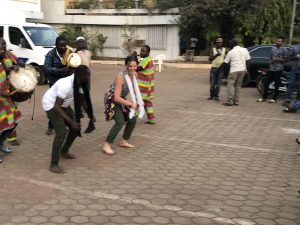
The second dance was described as being reminiscent of an old story about a king, his queen, and a friend-turned-monster. In this story, a king once married a beautiful woman. The king also had a friend named Jokiro, who became a menace and a monster to the king and his wife. The king consulted his friend (the monster) and he initially pampered him. Eventually though the friend began to demand all sorts of items from the king, creating many problems. The friend/monster then demanded that the wife must go outside of wedlock and get pregnant. The monster then impregnated the wife, infuriating the king. The king then sent warriors to kill the monster and therefore freed the wife. This dance, as the story goes, is typically performed by females who wish to celebrate their freedom. We were all very entertained as the dance involved each dancer repeatedly colliding with each other’s buttocks in mid air while moving in a circle.
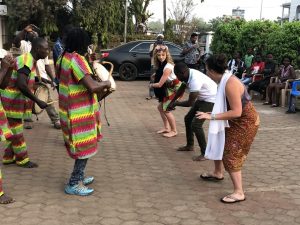
The final dance we observed consisted of many individual dances. The performers explained how each family, village, or group would have their own unique dance moves. The dance was intended to be an expression of individuality, as each dancer would do their own unique dance to the beat of the drums.
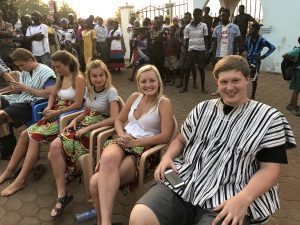
After each member of the group had performed their dance the group asked members of our class to learn some traditional moves. We had a great time dancing with them and got some great photos!
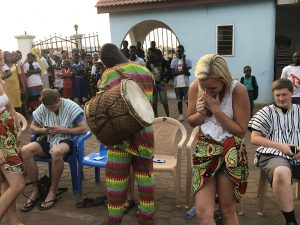
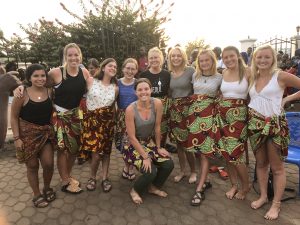
We are looking forward to tomorrow!